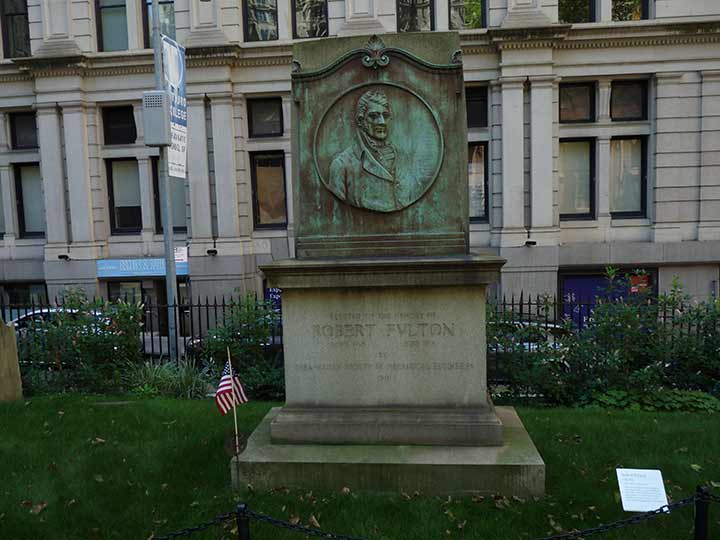
I recently walked around lower Manhattan and was glad to see Trinity Cemetery fully open again after years of partial closures during the pandemic. However, I was a bit disappointed to see that the old stones are more strictly guarded than in the past, with chain links completely lining the pathways; in other words, you can’t go on the grass anymore, making it tough to photograph inscriptions on stones that are angled away from the paths. I suppose there was an uptick in vandalism, forcing Trinity Church to do it. I did squeeze off some shots, and will present them here periodically. (The best time to do this is with a high overcast to provide even lighting; trees tend to cast shadows on the stones in sunny weather, making lighting uneven.)
Here’s the grave of the most famous steamboater in history. While not the inventor of the steamboat, Robert Fulton (1765-1815) was very instrumental in constructing a steamboat named the “Clermont” and parlaying it into a commercial success with the first permanent commercial route in history on the Hudson River.
Fulton was originally a landscape painter (as was the inventor of the telegraph, Samuel Morse, a historical portrait painter). In partnership with Robert Livingston, he designed and constructed a steamboat, his ultimate venture, named “The North River Steamboat, later called the “Clermont.” The craft left New York City, proceeding up the Hudson River to Albany in only 32 hours.
At age 49, at the height of his fame and while working on various projects, a serious cold developed into pneumonia, bringing about his death at his residence located in what is now Battery Place in lower Manhattan. His body lay in state there until a procession was formed conveying him to historic Trinity Church, the site of his funeral. Thousands lined the route as minute-guns were fired from a steam-frigate anchored off shore in the Hudson River and the New York Battery. His service was attended by representatives from both the National and State governments as well as high officials of the City of New York. Interment followed with placement beside his wife (nee Harriet Livingston) in her family vault at Trinity Churchyard Cemetery.
The vault became weatherbeaten and Robert Fulton’s name was never added to the list of the persons occupying the chamber and his resting place became hardly known. On the top of the vault was a brownstone slab, the inscriptions virtually obliterated. In 1901, the American Society of Mechanical Engineers sought to rectify this by the placement of a cenotaph marker, a short distance from the burial vault, a column bearing on one side a bronze medallion portrait.
As always, “comment…as you see fit.” I earn a small payment when you click on any ad on the site.
8/11/22


4 comments
Trinity Churchyard is the one downtown. Trinity Cemetery is the one uptown.
Oh I have an urge to be pedantic. The registered name of the boat was North River, or North River Steamboat. Clermont was the nominal home port, the home of investor Robert Livingston, so the boat did have the name Clermont on it, and so everybody calls it Clermont. There now I can relax.
I’m a retired NYPD officer spent most of my time in the Tactical Patrol Force. Manhattan South Unit we patrolled Central Park South to the Battery. In the 6th Pct (Greenwich Village) on west 11 th Street between 5th & 6th Aves was a tiny cemetery I seem to recall that it was the final resting place for Portuguese Seamen. I always meant to follow up on that place but never did/
The Second Shearith Israel Cemetery. It was larger until 11th Street was built through it in the 1800s.